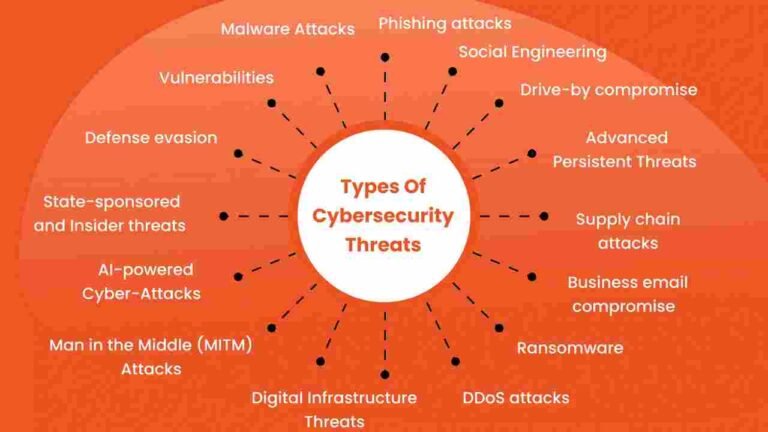1. Phishing Attacks
Phishing is one of the most common cyber threats. Attackers send fraudulent emails or messages pretending to be trustworthy sources to trick individuals into revealing sensitive information like passwords, credit card numbers, or login credentials.
Defense Strategies:
- Always verify the sender’s email address
- Avoid clicking suspicious links or downloading unknown attachments
- Use email filters and anti-phishing software
2. Ransomware
Ransomware is malicious software that encrypts files on your device or network, demanding payment to unlock them. It can affect individuals, businesses, and even critical infrastructure.
Defense Strategies:
- Keep regular backups of important data
- Install reputable antivirus and anti-malware software
- Avoid downloading files from untrusted sources
3. Malware and Spyware
Malware includes viruses, worms, trojans, and spyware that infiltrate devices to steal data, monitor activity, or damage systems. These threats can be spread through infected downloads, malicious websites, or email attachments.
Defense Strategies:
- Use updated antivirus and anti-malware programs
- Avoid clicking unknown links or visiting suspicious websites
- Keep operating systems and software up to date
4. Social Engineering
Cybercriminals often manipulate individuals through social engineering, exploiting human psychology to gain access to confidential information. Common tactics include impersonation, fake surveys, or urgent requests for sensitive data.
Defense Strategies:
- Be cautious with unsolicited requests for personal information
- Verify identities before sharing confidential information
- Educate employees about social engineering risks
5. Weak Passwords
Weak or reused passwords make it easy for hackers to gain unauthorized access to accounts. Attackers use brute-force attacks or credential-stuffing techniques to break into accounts.
Defense Strategies:
- Use strong, unique passwords for each account
- Enable two-factor authentication (2FA)
- Use a secure password manager to store credentials
6. Insider Threats
Not all threats come from outsiders. Employees or contractors with access to sensitive systems can intentionally or unintentionally compromise security. Insider threats may involve data theft, sabotage, or accidental leaks.
Defense Strategies:
- Limit access based on roles and responsibilities
- Monitor system activity and audit user actions
- Conduct regular employee cybersecurity training
7. Denial-of-Service (DoS) and Distributed Denial-of-Service (DDoS) Attacks
DoS and DDoS attacks overwhelm servers or networks with traffic, causing disruption of services. They can target websites, applications, or entire networks.
Defense Strategies:
- Implement network monitoring and traffic filtering
- Use DDoS mitigation services and cloud-based protection
- Maintain backup servers and redundancy
8. Man-in-the-Middle (MitM) Attacks
In a MitM attack, cybercriminals intercept communications between two parties to steal or manipulate data. This often occurs on unsecured Wi-Fi networks.
Defense Strategies:
- Use secure and encrypted connections (HTTPS, VPN)
- Avoid public Wi-Fi for sensitive transactions
- Enable encryption for emails and messaging platforms
9. IoT Device Vulnerabilities
Internet of Things (IoT) devices such as smart home gadgets, wearable devices, and connected appliances often have weak security. Hackers can exploit these vulnerabilities to gain unauthorized access to networks or personal data.
Defense Strategies:
- Change default device passwords and use strong credentials
- Keep device firmware updated
- Separate IoT devices on a dedicated network
10. Zero-Day Exploits
Zero-day exploits target software vulnerabilities that are unknown to the developer, making them difficult to defend against. Hackers exploit these weaknesses before a patch or update is released.
Defense Strategies:
- Keep software and operating systems updated regularly
- Use comprehensive security solutions with real-time threat detection
- Monitor cybersecurity alerts for new vulnerabilities
Conclusion
Cybersecurity threats are constantly evolving, targeting individuals, businesses, and organizations worldwide. Awareness of the top threats—such as phishing, ransomware, malware, and social engineering—combined with proactive security measures is essential to stay protected. Implementing strong passwords, regular software updates, multi-factor authentication, and employee education can significantly reduce the risk of cyberattacks and safeguard your digital assets.

